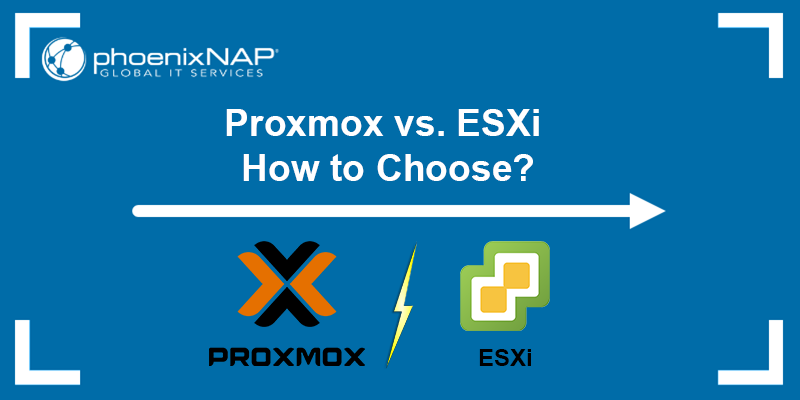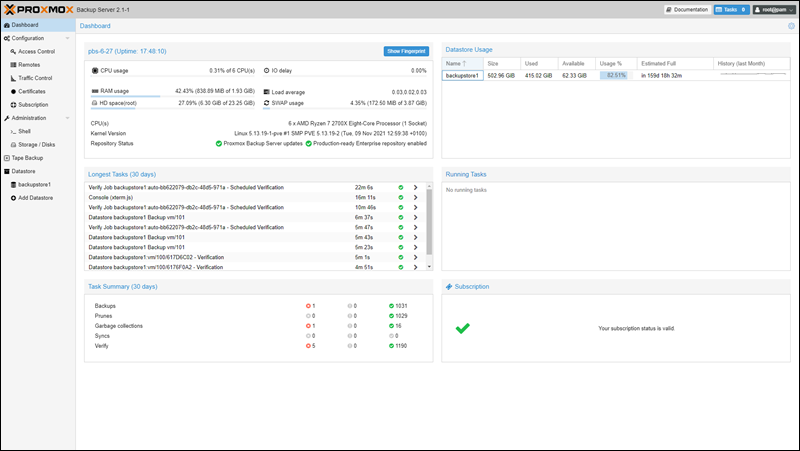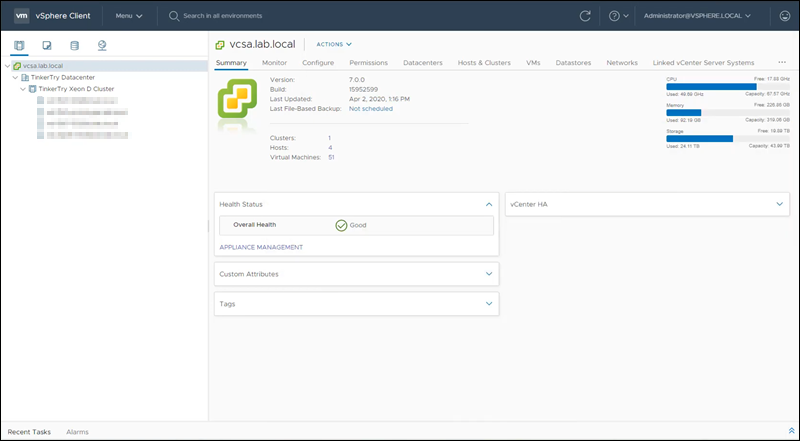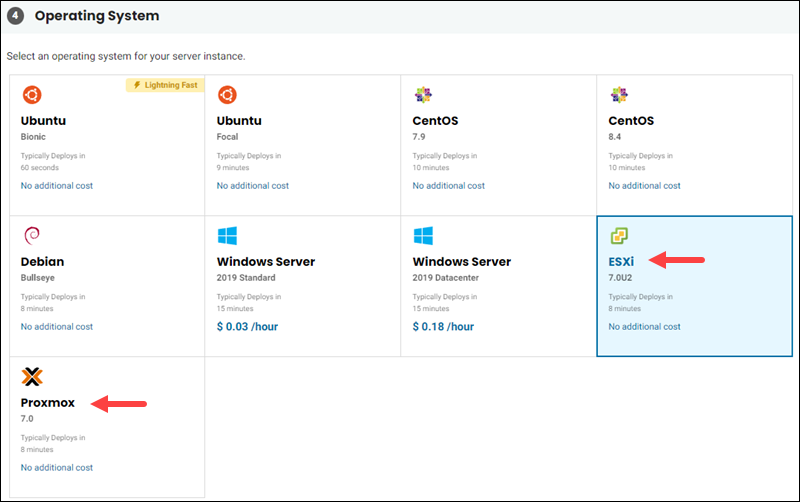Introduction
A hypervisor is virtualization software used for creating and running virtual machines (VMs). Hypervisors run on host machines, while guest machines are VMs created and managed by the hypervisor.
The benefit of using a hypervisor is that it allows users to run multiple instances of various operating systems that share the same hardware resources. Two highly popular production-ready hypervisors are Proxmox and VMware ESXi.
In this article, you will learn the differences between Proxmox and ESXi and get advice on choosing the right hypervisor for your organization.

Proxmox vs. ESXi: Definitions
Proxmox and ESXi are both type-1 hypervisors. They run directly on the host machine hardware and use it for guest operating systems. Type-1 hypervisors are often called native or bare metal hypervisors.
Type-2 hypervisors run inside the host machine's operating system just like any common software.
Note: Learn what hypervisors are, see hypervisor types, and the key differences between them.
Proxmox
Proxmox VE (Virtual Environment) is an open-source and completely free software server that enables enterprise-class virtualization. It is based on Debian Linux, allowing users to utilize KVM full virtualization for Windows and Linux images or lightweight Linux containers (LXC) for running Linux apps.
Note: Learn how to install Proxmox.
Proxmox features a built-in web interface for managing VMs, containers, and associated resources on multiple nodes and clusters.

ESXi
ESXi is an enterprise bare metal hypervisor developed by VMware. It is an integral part of the vSphere virtualization suite, along with the vSphere management portal for managing the ESXi virtual server.
Another tool that complements and facilitates ESXi management is the vCenter Server. It is a centralized application for managing virtual machines and multiple ESXi hosts via the vSphere web client.

The ESXi utility is free as part of the vSphere hypervisor but requires a paid license after 60 days to continue managing ESXi via the vCenter server. After 60 days, the software limits resources to two physical CPUs for the host machine and a maximum of 8 vCPUs for each virtual machine.
However, the free ESXi version allows users to run limited VMs with no limit on memory or CPU core number.
Proxmox vs. ESXi: Comparison
The following section shows an overall comparison between Proxmox and ESXi. For an overview of key features, refer to the table below:
| Proxmox | ESXi | |
|---|---|---|
| Software Type | Open source | Proprietary code |
| Basis | Debian Linux KVM | VMkernel |
| Central Management | Yes | Yes |
| Clustering | Yes | Yes |
| High Availability | Yes | Yes |
| Storage and Backup API | Yes | Yes |
| Live Migrations from VMs | Yes | Yes |
| VM Load Balancing | Yes | Yes |
| Free Trial | Unlimited | 60 days |
| Pricing | Free with full features. | Full features require a paid license. |
Features
Proxmox
Proxmox boasts a staggering number of features, one of the most prominent ones being its web-based GUI or CLI with Unix shell or Windows PowerShell that facilitates VM management. Apart from the UI, other notable features are:
- High-Availability Cluster Management. Used to manage a multitude of nodes.
- Live Migration Capabilities. Ensuring low downtime.
- Backup Server. Ensures redundancy and incremental backups for single-file and live-restores.
- Database-Driven File System. Used for synchronizing configuration files.
- Third-Party Support. Third-party tools integrate easily with RESTful API, with JSON being the primary data format.
- Multi-Master Policies. Used for deploying cluster-wide tasks and for maintenance.
- Built-In Security. Integrated firewalls with separate controls for macros, security groups, aliases, and IP sets.
- VM Image Storage. Store VM images locally using LVM containers or ZFS filesystems or shared storage such as NFS or iSCSI.
- Bridge Networking Model. Supports IPv4 and IPv6 and up to 4094 bridges per host.
ESXi
ESXi shares most of the Proxmox features, but it stands out with some of its advanced features for global enterprise clients, especially with native Kubernetes support.
Other prominent ESXi features are:
- Built-in GUI. ESXi offers a GUI interface available through HTML5 vSphere CLI or REST-based APIs.
- Quick Boot. Suspends VM to memory to boost boot speed and reduce downtime.
- Security. Advanced security options, including encryption, role-based access, logging, and auditing.
- Compatibility. Compatible with many apps, workloads, and configurations.
- Storage. High-capacity policy-driven, 4K native storage.
- vMotion. Ensures an easy migration and hybrid workload provisioning.
- Native Kubernetes Support. Supports on-premises k8s clusters using the Tanzu container orchestration service.
- Hybrid Linked Mode. A service controller for linking multiple vCenters.
- Backup. Provides backup and restoration options using REST APIs and vCenter Server Appliance.
Performance
Both type-1 hypervisors offer excellent performance capabilities suitable for a wide variety of configurations. However, ESXi, an industry-standard virtualization solution, provides greater RAM and host capacities than Proxmox.
The following table shows an overview of different capabilities:
| Proxmox | ESXi | |
|---|---|---|
| Maximum Physical Memory | 12TB | 24TB |
| Maximum Number of Hosts per Cluster | 32 | 96 |
| Maximum CPU Number | 768 | 768 |
While Proxmox offers the same capacities for all users for free, ESXi offers several performance tiers based on licensing, increasing the number of hosts in a cluster and RAM amount per host.
Regarding backup solutions, Proxmox Backup Server is an enterprise-level utility for backing up and restoring VMs, containers, and hosts. The supported functionalities include incremental backups, deduplication, Zstandard compression, and authenticated encryption.
The free version limits ESXi backup solutions, and file-based backups using native applications are required. Additionally, since the free version has no backup solutions in the vCenter app, it is not recommended for use at an enterprise scale.
Clustering

Proxmox
Proxmox supports clustering and offers centralized management of multiple servers from a single web management console. The web console is handy for managing server farms. Proxmox Cluster provides numerous authentication methods and facilitates VM and container migration in the cluster.
Create clusters of up to 32 physical nodes and configure them all from the web console. For a multi-node setup, use two Proxmox servers or more for maximum availability.
For example, phoenixNAP Bare Metal Cloud instances support a wide OS selection, including ESXi and Proxmox. Select your preferred instance type and OS with a few clicks and deploy a virtualization server in under 10 minutes.

ESXi
A requirement for creating ESXi clusters is the VMware vCenter Server. Multiple hosts provide the processing, memory, and network resources to the cluster configuration and protect the VMs in the cluster from physical server failures.
After creating a vSphere cluster, users get access to High Availability and Distributed Resource Scheduler features, which oversee the resource distribution and protect data.
The maximum ESXi cluster capacity is 1024 datastores within a cluster of a maximum of 32 ESXi hosts.
However, the free ESXi version offers limited functionality for clustering and High Availability. Unlock the features by obtaining an ESXi license.
Note: See our tutorial for setting up a Bare Metal Cloud instance as a load balancer for a server cluster.
Ease of Use
Proxmox
Proxmox has an integrated GUI that allows users to complete all management tasks in one place, excluding the need for a separate management tool. The web interface is based on the ExtJS JavaScript framework and supports all browsers.
Since Proxmox is based on Linux (Debian), it is quite easy to learn and use out of the box if you already have knowledge about Linux. However, since it is open-source, the Proxmox GUI is still evolving, and some advanced options still require the command line.
ESXi
The vSphere web client used for VM management is intuitive and offers advanced configuration features. However, you need the vCenter Server utility with its own host or a guest VM to manage multiple ESXi hosts.
Compared to Proxmox, which is based on Linux, ESXi has its own proprietary Linux and management tools that users must learn to use.
Note: An alternative for VMs are containers. Learn the difference between virtual machines and containers.
Portability
Proxmox
Proxmox supports various image formats, including HDD, QCOW, QCOW2, QED, VDI, etc. The comprehensive image support improves VM portability and OS support in the guest VM.
However, importing/exporting an image is not very straightforward and includes using the CLI and the Proxmox Backup Server utility. The most viable option for moving an image to another VM is to back up the configuration and restore it on another VM.
ESXi
When using SAN-based (storage area network) storage, ESXi allows you to shut down or suspend a VM on one server and power it up on another one with a few clicks in the GUI. The advanced ESXi portability features enable users to have consistent shared access while migrating the computing resources.
Compared to Proxmox, ESXi has proprietary virtualization technology, and supports fewer VM image formats, resulting in fewer OS being supported. The most used export format is OVF, which captures the VM's state in a package.
Security
Proxmox
Being Linux-based, Proxmox boasts advanced built-in security features and automatic backups for user-specified nodes while providing enterprise-level performance. Additionally, since all VMs in Proxmox run within containers, any potential issues or bad code in one VM doesn't affect others.
Its open-source nature helps Proxmox developers quickly address bugs and security gaps by making it a priority in the development community.
Proxmox Backup Server features a data encryption feature that protects data integrity by encrypting all client-server traffic. It prevents unauthorized access by limiting users to only the access level they require for their user role.
ESXi
ESXi improves security by running only the services essential for its operation.
For example, ESXi disables Shell and SSH interfaces by default, and users can perform all activities using the vSphere Client. The vSphere Client provides users with role-based access.
Note: See how to enable SSH on ESXi if you decide to use an SSH connection.
To further increase security, only some firewall ports are open by default. For example, services such as FTP and Telnet aren't installed, and their ports are closed.
An internal service modified to run only the functions required for administration and monitoring manages access to the web interface. The web interface limits reduce ESXi's vulnerability to security issues on the web.
Support
Both hypervisors offer a paid subscription that includes professional tech support.
Proxmox
Being open-source, Proxmox has a developed community and a Wiki with plenty of resources that help resolve various issues users may encounter.
On the other hand, a Proxmox VE Subscription provides access to the Proxmox Enterprise Repository, regular software and security updates, and the Proxmox technical support team.
With a paid subscription, users can submit a ticket to Proxmox developers or book training for system administrators.
ESXi
Support is the most significant difference between a free and paid ESXi version.
The free ESXi version offers good online documentation and access to an active vSphere Community, including a section on ESXi. The free version is an excellent choice for a home setup, but we advise against running it in a production environment due to the lack of official support.
VMware provides users with different service-level agreement tiers and support for paid subscriptions. There are also certification courses for ESXi, which can be quite costly but are worth the time and money.
Pricing
Proxmox
A paid subscription is optional, and Proxmox offers all its features for free. If you choose to subscribe, you get access to the enterprise repository and technical support from Proxmox developers.
The subscription pricing tiers at the time of writing this article are shown in the table below:
| Proxmox License Level | Cost and Support Options |
|---|---|
Community | €95/year and CPU socket |
| Basic | €295/year and CPU socket Three support tickets per year. |
| Standard | €445/year and CPU socket Ten support tickets per year. |
| Premium | €890/year and CPU socket Unlimited support tickets. |
All tiers offer access to the Enterprise Repository, community support, and a complete feature set.
ESXi
The free ESXi version has no official support, so a paid subscription is essential if it is used at an enterprise level.
The pricing tiers for ESXi at the time this article was written are as follows:
| ESXi License Level | Cost and Support Options |
|---|---|
| Essentials | $576.96/year Up to three hosts with up to two CPUs each. Base server virtualization and management. |
| Standard | $1,268/year Entry-level solution for basic server consolidation. Includes infrastructure image management and faster app deployment. |
| Enterprise Plus | $4,350/year Full feature range features, including data-at-rest encryption, flexible IT services, replication, etc. |
| Essentials Plus | $5,596/year Up to three hosts with up to two CPUs each. Server virtualization and consolidation with centralized management. Includes vMotion, vSphere Data Protection, High Availability features. |
Proxmox vs. ESXi: How to Choose?
Both Proxmox and ESXi are type-1 hypervisors that run on bare metal servers, but they usually serve different purposes. Choose between Proxmox and ESXi by considering several factors:
- Your business' size.
- Scalability options.
- Budget and cost-effectiveness.
- Performance capabilities (including clustering, backups, and portability).
- Ease of use and management.
ESXi offers multiple licensing options with different feature sets that suit each business' needs. ESXi is usually an enterprise-level solution with advanced features, an extensive network, and costly enterprise resources.
On the other hand, Proxmox suits organizations that require more in-house control of their virtualization capacities, with a price for official support that costs much less than ESXi's.
Additionally, Proxmox is based on Linux and easy to learn for users accustomed to a Linux OS, whereas ESXi has its proprietary code and a steeper learning curve.
Conclusion
After reading this comparison article, you know the similarities and differences between Proxmox and ESXi and the use cases for each hypervisor. Check out our Proxmox vs Hyper-V comparison article to learn the differences between these two hypervisors.
Next, learn how to deploy a Bare Metal Cloud server with your preferred virtualization software in a few clicks.